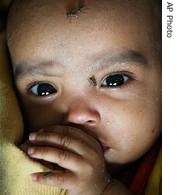2007年VOA标准英语-India Lags Behind Other Countries in Access to(在线收听)
New Delhi
22 April 2007
India is lagging behind many countries in providing anti-retroviral drugs to people afflicted with the AIDS virus. As Anjana Pasricha reports from New Delhi, officials say efforts are being made to step up access to the drugs, in the country estimated to have the highest number of HIV victims in the world.

A reportedly HIV positive baby girl Harini, 4-months-old, at an orphanage in Chennai, India (File)
A recent report by the World Health organization, UNICEF and UNAIDS estimates that less than 15 percent of HIV-positive people in India who need anti-retroviral drugs are receiving them.
The report says 55,000 people get anti-retroviral therapy at government centers, and another 15,000 at private clinics. That is only a small proportion of those whose immune systems are so damaged that anti-retroviral drugs are prescribed.
The number of HIV-positive women receiving drugs for prevention of transmission from mother to child is even lower - a meager three percent.
Overall, India is estimated to have 5.7 million HIV carriers, which is thought to be the highest number of any country in the world.
But the report notes that India lags behind several other high-prevalence countries. For example, in South Africa, as many as 32 percent of HIV patients needing medication have access to the drugs. In Kenya, the figure is 44 percent, and in Nigeria, 26 percent.
The head of India's National AIDS Control Organization, Sujata Rao, says India has to identify patients who need the treatment before it can significantly expand coverage.
"Our biggest challenge today is phenomenally upscaling the access to testing…. We need to test 22 million people per year," said Rao. "Unless we expand the pool of the tested number, we will not be able to get the number of people, the patients or the mothers to whom we need to reach out. This is where we are going to be focusing attention on."
Indian officials meanwhile say new concerns have emerged about the spread of HIV among injecting drug users, or IDUs.
It was believed that most such cases were concentrated in the remote northeast. But Sujata Rao says the virus has been found among IDUs in other parts of the country.
"There is now evidence to certainly show [that] Delhi, Punjab, Mumbai, that means in the mainland of the country, also we do have IDU, and HIV transmission through IDU. That makes it a larger problem," said Rao. "That is something of concern because it is mainly young people who take to drugs, and it is very difficult to put them off drugs, they are difficult to access, difficult to work with."
Indian officials say the cornerstone of the country's strategy to control the spread of AIDS remains prevention, and it is stepping up education and awareness programs as well as distribution of condoms.